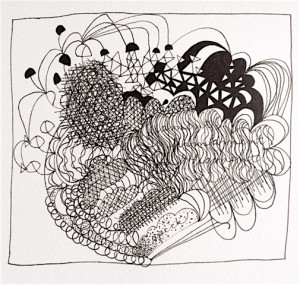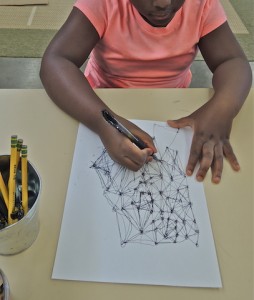“What happens when you mix MATH, CORAL, AND CROCHET?
It’s mind-blowing!” By Rebekah Barnett
Also, click on Crochet Coral Reef to learn more!

“What happens when you mix MATH, CORAL, AND CROCHET?
It’s mind-blowing!” By Rebekah Barnett

Also, click on Crochet Coral Reef to learn more!

I am back to Gloworm after a six month hiatus and want to introduce my new family member – FINN – a golden retriever puppy!
Also, I am finding time to doodle again!
“Art is literacy of the heart.”
– Elliot Eisner
 Ten Lessons the Arts Teach
Ten Lessons the Arts Teach1. The arts teach children to make good judgments about qualitative relationships. Unlike much of the curriculum in which correct answers and rules prevail, in the arts, it is judgment rather than rules that prevail.
2. The arts teach children that problems can have more than one solution
and that questions can have more than one answer.
3. The arts celebrate multiple perspectives.
One of their large lessons is that there are many ways to see and interpret the world.
4. The arts teach children that in complex forms of problem solving
purposes are seldom fixed, but change with circumstance and opportunity. Learning in the arts requires the ability and a willingness to surrender to the unanticipated possibilities of the work as it unfolds.
5. The arts make vivid the fact that neither words in their literal form nor numbers exhaust what we can know. The limits of our language do not define the limits of our cognition.
6. The arts teach students that small differences can have large effects.
The arts traffic in subtleties.
7. The arts teach students to think through and within a material.
All art forms employ some means through which images become real.
8. The arts help children learn to say what cannot be said.
When children are invited to disclose what a work of art helps them feel, they must reach into their poetic capacities to find the words that will do the job.
9. The arts enable us to have experience we can have from no other source
and through such experience to discover the range and variety of what we are capable of feeling.
10. The arts’ position in the school curriculum symbolizes to the young
what adults believe is important.
SOURCE:
Available from NAEA Publications. NAEA grants reprint permission for this excerpt from Ten Lessons with proper acknowledgment of its source and NAEA.
We read What Do You Do With an Idea? Written by Kobi Yamada and illustrated by Mae Besom.
Then, with the art tools and materials shown above, children envisioned and expressed their ideas in many different ways.
“What do ideas become? Big things, brave things, smart things, silly things, good things. Things like stories, artwork, journeys, inventions, communities, products and cures. Everything you see around you was once an idea.”
Dear Friends,
This was first posted on gloworm in October 2012 and still holds true!
One of the purposes for the blog is to communicate with the Park School community about what’s happening in art in grades 1, 2 & 3. What we teach in art and why are centered around the “Studio Habits of Mind.”
To learn and grow as artists we encourage children to explore a wide variety of art tools and materials and to practice basic skills. Investigations in two and three-dimensional art media invite children to express their thoughts, feelings and ideas in new ways.
The 8 Studio Habits of Mind*
1. Observe – Look beyond the ordinary. Notice things that otherwise might not be seen.
2. Develop Craft – Learn how to use art tools and materials. Understand techniques. Care for tools, materials and the art room.
3. Envision – Picture mentally. Imagine possible next steps.
4. Express – Create works that convey an idea, a feeling, or a personal meaning.
5. Stretch and Explore – Reach beyond the familiar and explore playfully. Embrace opportunities to learn from mistakes and accidents.
6. Engage and Persist – Solve problems of personal importance. Develop focus and follow through on an idea.
7. Reflect – Question, think and talk with others about one’s work and working process. Evaluate one’s own work and working process.
8. Understand Art in the World – Learn about art history and current practice. Interact as an artist with other student artists.
*Adapted from Studio Thinking: The Real Benefits of Visual Arts Education, Lois Hetland, Ellen Winner, Shirley Veenema, Kimberly M. Sheridan, David N. Perkins, Teachers College Press, 2007.
I hope you will follow “gloworm” this year! Either subscribe or bookmark mshesaltine.edublogs.org
Sincerely,
Nancye Hesaltine
 Would you like to understand the developmental stages of your children’s drawings?
Would you like to understand the developmental stages of your children’s drawings?
Click on the link above to read a brief summary from Creative and Mental Growth by Viktor Lowenfeld, Macmillan Co., New York, 1947.
We watched parts of Cave Art in the Tropics (click link in post below) to see the cave paintings in Indonesia that were made about the same time as the cave paintings in Europe.
After talking, we used our own hands as a starting point, and drew, colored and painted to express our thinking and ideas.
Grades 1, 2

![]() Photo Credit: Sarah Spaulding via Compfight
Photo Credit: Sarah Spaulding via Compfight
To read the essay, click on Nine Things Educators Need to Know About the Brain, by Louis Cozolino, syndicated from Greater Good, June 02, 2013.
In our final week, we looked at some of the sketched story boards for Kiki, made mini accordion books and drew in them. We watched part of the film, Kiki’s Delivery Service directed by Hayao Miyazaki, Japan’s great animator and director.
Many of Miyazaki’s beautiful animations are drawn and painted by hand. Some of his other compelling films are My Neighbor Totoro, Ponyo, Castle in the Sky and Spirited Away. To learn more about Miyazaki, click on www.nausicaa.net/miyazaki/miyazaki
Here’s a link from second grade Park teacher, Katie Englander. Click on The Top 10 Skills Children Learn from the Arts to read the article by Lisa Phillips, blog journalist and arts / leadership educator.
Lisa Phillips also has an informative website called The Artistic Edge – Equipping our children for a successful future.